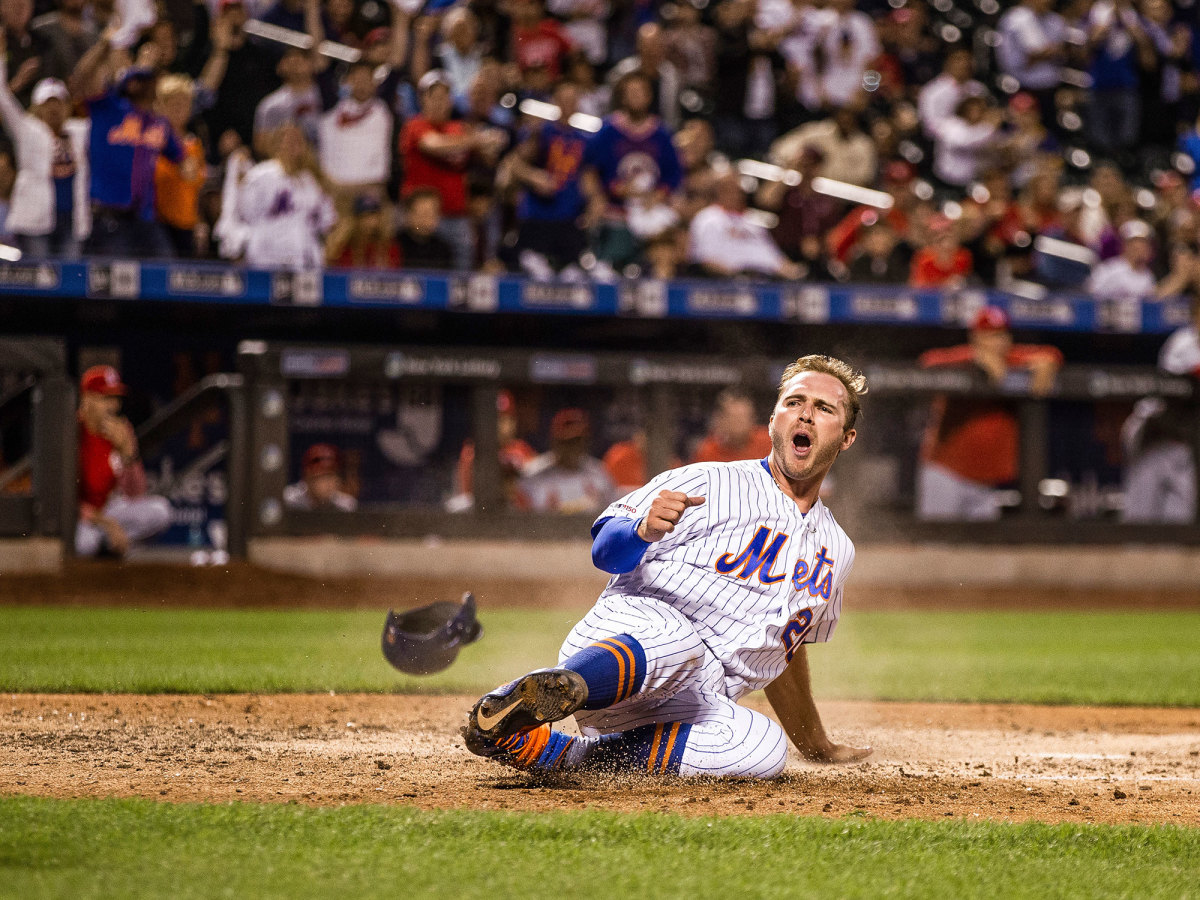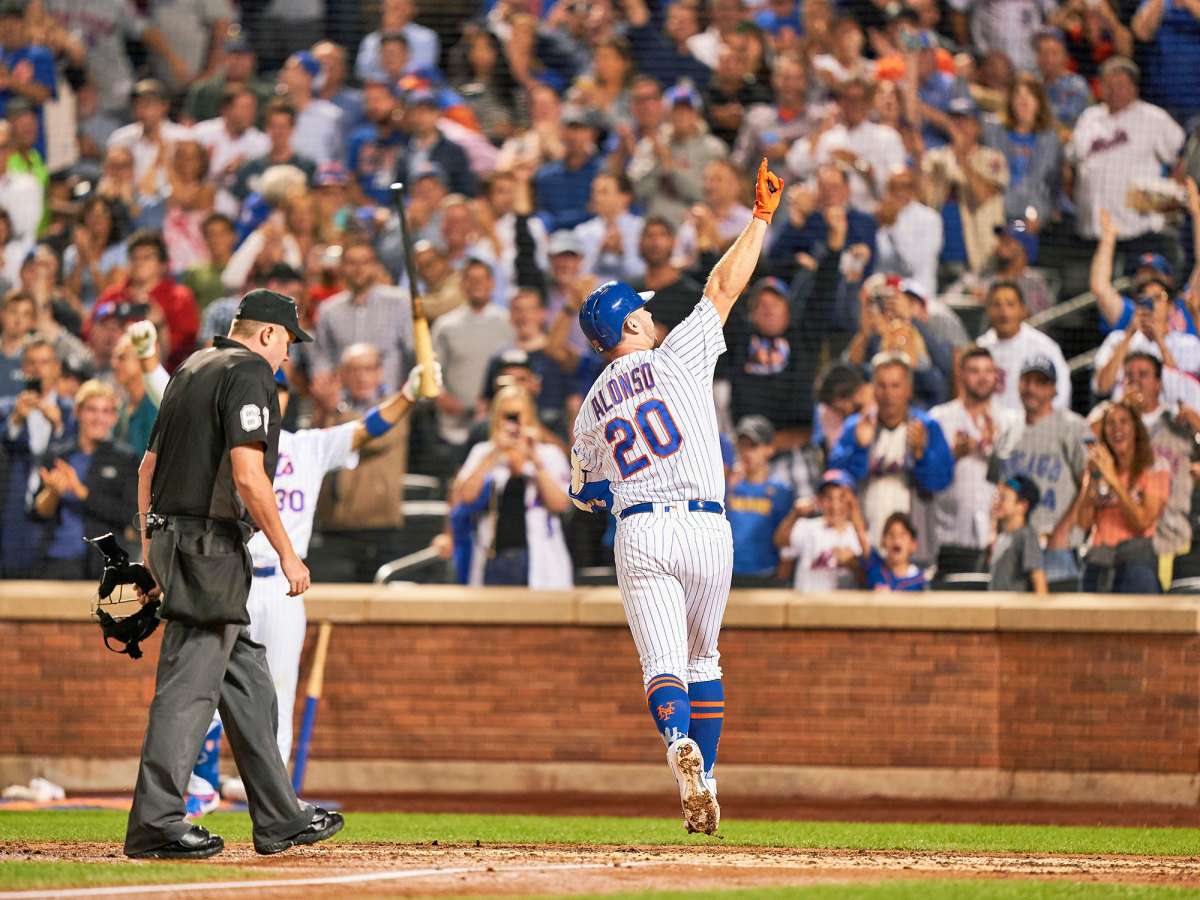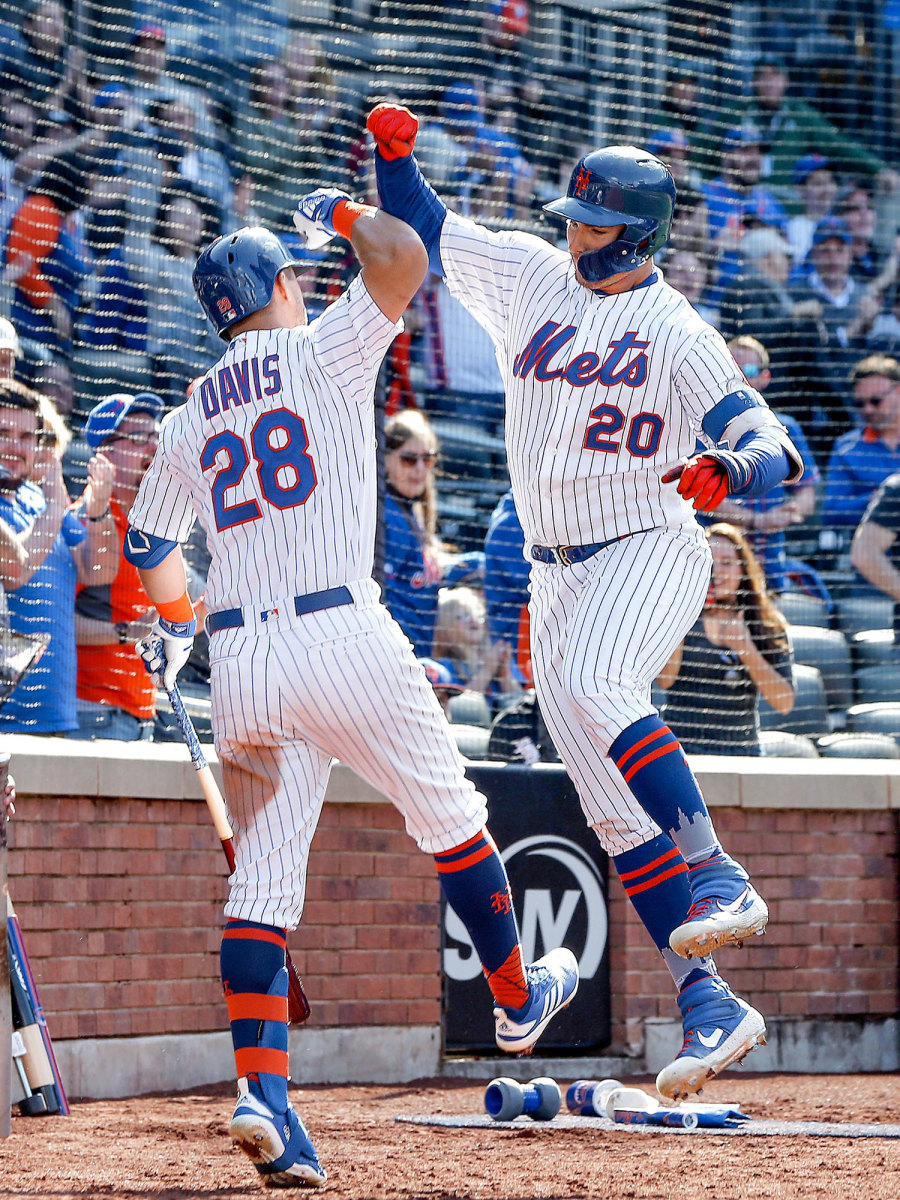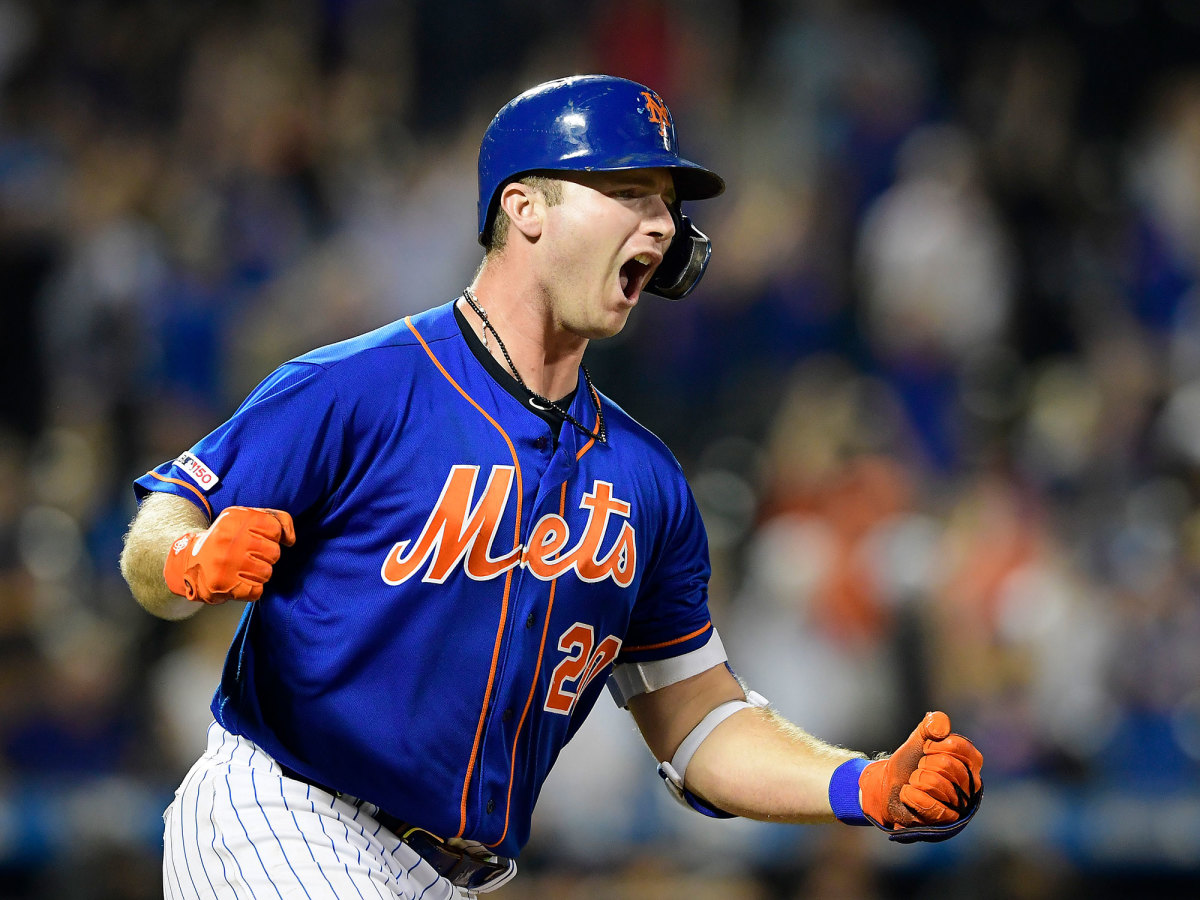Never Mind He's on the Mets. Pete Alonso Is the Happiest Man in Baseball

This story appears in the Sept. 23, 2019, issue of Sports Illustrated.For more great storytelling and in-depth analysis, subscribe to the magazine and get up to 94% off the cover price. Click here for more.
Pete Alonso has lived in the city only since April, but he's already driving like a New Yorker. He easily merges his Lexus SUV into traffic on the FDR Drive and navigates the narrow lanes. He swings calmly off the RFK Bridge onto the Grand Central Parkway. When a teenager threatens to dart in front of the car near Citi Field, Alonso shakes his head and laughs. "Don't do it, man! Don't do it!" (The kid does not.) Alonso is 24. He seems older as he asks three preteen autograph hounds why they're not in school, but younger as he begins enumerating the things he likes about his life in 2019.
He likes that he has driven this route to Citi Field so many times that he knows the way without GPS. He likes that in a few days he will climb onto a team plane bound for yet another major league city. He liked hauling boxes into the Upper East Side one-bedroom he shares with his fiancée, Haley Walsh, because it meant he was home. He likes pitching changes, because he can practice taking a secondary lead off first base (which still amuses his teammates). He likes social media, unlike most in the public eye, because of all the encouragement he gets. He cannot immediately think of a curse he can't turn into a blessing.
Occasionally this drives his teammates crazy. Alonso related a scene from an August game against the Indians during which the Mets endured two rain delays. The first, at two hours and 28 minutes, clocked in at a minute shorter than that afternoon's Cubs-Giants tilt. The second began at a quarter to midnight. As his teammates sat at their lockers, calculating the hours of lost sleep, Alonso delivered a call to arms. "First and third, bottom of the eighth!" he roared. "We're going to step on their neck when that tarp comes off at 3 a.m.!" (As it turned out, the game was called, with the Mets ahead 2-0, at 12:23.)

The averageness of New York's record (71-68 as of Sept. 5; four and a half games out of a wild-card spot) may mask the season's extreme highs (a 15-1 run, a batting-title bid from utilityman Jeff McNeil) and lows (six straight home losses in August with a playoff spot in the balance; starter Jason Vargas, now in Philly, threatening a reporter to a fight). Whatever, though, comes of the season, it is likely to be remembered as the year the Polar Bear planted his size 13 feet firmly in Flushing.
The rookie first baseman has smacked so many dingers (45), with such prodigiousness, that he has already become one of the team's most fearsome hitters and unquestioned leaders. He outslugged Ronald Acuña and Vladimir Guerrero Jr. in the Home Run Derby, broke the NL rookie and Mets franchise records for home runs in a season (39 and 41, respectively), and will almost certainly claim NL rookie of the year in November. In the process, the righthander has also proven himself a more enthusiastic cheerleader than Mr. Met. He is a repository of choreographed dugout handshakes and is often the first to chase a teammate down after a walk-off. Twice this year he tore off teammates' jerseys in postgame celebrations.
Alonso's fellow Mets consider him the most optimistic man in baseball. Whether he's really Dr. Pangloss, or whether he's just a wide-eyed rookie whose heart the game has yet to break, the dissonance between Alonso's sunny manner and the nearly annual gloom in Queens presents a polar bear-sized question: Can their prized young first baseman stay this happy, and this good, when everything isn't quite so novel?
"I've been told I look at life through rose-colored glasses," Alonso says. But he's quick to point out that so far he's been right. "I'm not going to say I got everything figured out, because I don't," he says. "But it's like, man, maybe I know some things."
Many would-be saviors have graduated from the farm system to Flushing, and most have failed. The lineage stretches back to catcher Steve Chilcott, whom the team took No. 1, ahead of Reggie Jackson in the 1966 draft. Jackson became a Hall of Famer. Chilcott never played a major league game. Former teammates cheered when Gregg Jefferies, a two-time Minor League Player of the Year as a slugging shortstop, was run out of town after parts of five seasons with the big club. Defensive wizard shortstop Rey Ordoñez, a three-time Gold Glover in the '90s, never developed as a hitter. The team's three ballyhooed pitching prospects in '95—Bill Pulsipher, Jason Isringhausen and Paul Wilson, known as Generation K—had all suffered major injuries by '98. None won even 25 games for the Mets. Outfielder Lastings Milledge, the No. 9 prospect in all of baseball in 2006, was swapped for role players a season later after, among other calamities, the Mets denounced a rap song he appeared on.
Even when the organization creates a star, he tends to implode. Righty Dwight Gooden and outfielder Darryl Strawberry had productive careers, and helped the Mets win the 1986 World Series, but found their Hall of Fame potential derailed by drugs, alcohol and mismanagement. Righty Matt Harvey became a phenomenon—"Happy Harvey Day," fans would greet one another—but he has a 5.65 ERA since his ill-fated assurance that he could finish out Game 5 of the 2015 World Series, which the Royals won in 12 innings to clinch the Series.
Allows Alonso, "It's a little bit easier to be a Yankees fan."
These days the Mets have one of baseball's better homegrown cores, with Alonso, McNeil, outfielder Michael Conforto, emerging shortstop Amed Rosario and pitchers Jacob deGrom, Noah Syndergaard, Zack Wheeler and Steven Matz. But management has struggled to surround them with much. In December new general manager Brodie Van Wagenen traded two top prospects for second baseman Robinson Canó and closer Edwin Díaz. Canó had a career-low .710 OPS before he tore his left hamstring in August. Díaz's 5.29 ERA is worst among pitchers with at least 20 save opportunities. Setup man Jeurys Familia, on a three-year deal, has been even less effective than Díaz. Infielder Jed Lowrie, signed in January, has yet to make his Mets debut, owing to a mysterious series of injuries.

Given such mismanagement, it's hard to imagine the team would be playing games of any relevance in September without the surprising contributions of its big bopper. No one has had a better knack for the moment: Alonso leads the major leagues in game-tying and go-ahead home runs (20).
Alonso says he is a student of the "see ball, hit ball" school. He controls the strike zone well, and when he gets a pitch he likes, he demolishes it. If that seems simple, that's because, he says, it is. In college, "I had to worry about turning in a paper on the French Revolution the day we are playing No. 1-ranked Texas A&M. We've gotta face a first-rounder on the mound, and I've gotta crush a paper. Now ... " he laughs, "I've just gotta face [Max] Scherzer." (Alonso is 2 for 12 against him.)
When he played in the Cape Cod League before his junior year at the University of Florida, opponents would come by the field to watch his batting practices. Big leaguers are similarly impressed. During a June series at Wrigley Field, Cubs third baseman Kris Bryant asked Alonso if he could spare an extra Dove Tail PA20 bat. Bryant used it for about a week before exhaustion set in. He was having trouble dragging the 34-inch, 32-ounce lumber through the zone.
Mets fans may have been let down before, but all that past disappointment did nothing to deter their desire to see the big first baseman in Queens. Last year, with Pete tearing up minor league pitching and the Mets' hitters struggling, the West Bank Gourmet Deli in Manhattan added a sandwich to its board: the We Need Alonso.
Early in her son's first major league spring training, in 2018, Michelle Alonso and a cousin made their way through the stands before a game. They jumped up and down to get Pete's attention. He replied with an exuberant wave. An older teammate barked the old ballplayer's command: "Act like you've been there before." Michelle could see her son's shoulders slump.
"You haven't been here before," she told him later, "and you need to act like you haven't. Allow yourself to enjoy it, or else someday you'll look back on these highlights and regret that in the moment you felt like you had to numb yourself to it."
The message didn't take immediately. ("Mom, you don't get it.") But gradually she saw him return to himself. He never sulked after what he considered to be unfair treatment at the hands of the team last year. He led the minors with 36 home runs, which he hit at Double A Binghamton and Triple A Las Vegas, but the team didn't call him up, to delay his eventual free agency. Alonso decided to suppress his frustration and enjoy his time in Nevada. He hit a walk-off home run in his last game. He does not set out to prove the doubters wrong, he says. He wants to prove the believers right.
When manager Mickey Callaway informed Alonso, on the eve of this season, that the team would no longer be suppressing his service time—that he had made the major league roster—he cried. But while many rookies live in a hotel, just in case they get sent back down, he says he never considered it. "I kind of knew, if I'm going to be up there, I'm going to stay," he says. "I wasn't scared." So in mid-April, after the Mets returned from the second road trip of the season, he and Walsh signed a one-year lease.
After each game, he scrawls the details of his performance in a composition notebook he keeps in his locker. He records opportunities for improvement, but he also tries to see progress even in failure. 0 for 4 ... well, I took some really good swings. I fouled a few back.

Some of this he comes by naturally. When Dennis Braun, Alonso's coach at Plant High in Tampa, met the kid's parents, he was skeptical. Could these people possibly be that positive? Pete's father, a staffing consultant who is also named Pete, never complained about his son's playing time. Michelle, who used to work in a crime lab, brought pom-poms to games. Then Braun got to know them well enough that they now travel to Pete's games together. They're for real, he says.
So is Pete. In high school he'd jump in to break up fights. In the minors, without saying anything, he once placed a pair of new cleats in the locker of a teammate whose were held together with duct tape. And this year, in a July tweet, when the Mets were at their lowest, he exhorted fans to come to the ballpark, ending his missive with #LFGM—let's f------ go Mets—thus coining this season's catchphrase. "He could make anybody believe," says third baseman Todd Frazier, who gave Alonso the Polar Bear nickname in spring training.
Alonso has been surprised by how much he loves New York. A self-proclaimed country boy, he thought he might find the city overwhelming. (His younger brother, Alex, scoffs. "He didn't grow up country," he says. "Tampa is a city. He's culturally country.") But Alonso loves the peace Manhattan's pace provides. No one has much time to bother him. Once a doctor—or at least a man wearing a white coat near a hospital—caught his eye while rushing down the street. "Hey Pete, I love what you're doing! I gotta get to work! Stop swinging at sliders in the dirt!"
But he doesn't spend much time out and about—when he's in the city, he's at Citi. The Mets laud his work ethic, especially when it comes to his weakest area, his defense. It was Alonso's glove that dropped him to pick No. 64 in the 2016 draft. In high school he would miss balls rolled at him casually between innings. Braun can't count how many college coaches told him they had no room for such a stiff defender.
Before this season, though, Alonso informed Van Wagenen that he intended to mold himself into a Gold Glove first baseman. Weeks earlier the GM had surreptitiously watched Alonso before last year's Arizona Fall League All-Star Game. As the other prospects chatted and took selfies, Alonso sweated through ground balls at first. Every day this offseason he texted Van Wagenen a photo of the scale. He eventually lost 12 pounds, which brought the 6'3" Alonso down to a still-Ursus maritimus-like 245. Callaway insists the groundskeepers complain about Alonso's destroying the field with all his extra practice. Today, according to FanGraphs, he is almost a league-average defender at first.

None of this surprises Braun. "He would tweet, 'I'm gonna play in Citi Field. I'm gonna make it,'" says the coach. "People called me and were laughing. Just last year people from the Mets told me they didn't think he was ever gonna field in the big leagues." (Braun wouldn't say who.)
This is the sort of environment in which new Mets are expected to thrive. "It will be hard to knock the smile off my face," Bobby Bonilla said in December 1992, when he signed with the Mets. By June he was wearing earplugs to drown out the boos. DeGrom recently snapped, "I'm not talking about that" at a reporter. The proposed topic of discussion? The clubhouse Ping-Pong table.
Alonso, whose family calls him Peter, asked the Mets this spring to list him as Pete so he would seem more approachable. "I don't want him to lose that enthusiasm," says director of media relations Harold Kaufman.
So far, he has not. He stands patiently at his locker before and after games, accepting questions from all comers. He becomes practically giddy when the team informs him that various celebrities have requested an introduction: Jerry Seinfeld, Judd Apatow. They want to meet me? I want to meet them!
It is easy to be so positive when everything is new, when you are a rookie breaking records for a team that, for all its flaws, put up a surprising fight in the second half. What will test Alonso's temperament, though, are the penny-pinching offseasons and season-long slogs to which the Mets and their fans have grown accustomed. Will Alonso change their outlook, or will the Mets change his?
Alonso's optimism is not reflexive, he says. He chooses every day to see the glass as half full—or at least as refillable. "I just think that if you're thinking negatively it is very, very rare for positive results to come out," he says. He sees the 0 for 4s. He just chooses to focus on the good swings.
He likes that Mets fans choose to be Mets fans, even when the team brings them pain. He likes that sometimes he can turn that pain into joy. His high-rise overlooks the East River, but he likes that his apartment does not have a coveted water view, because he likes to see the city.
